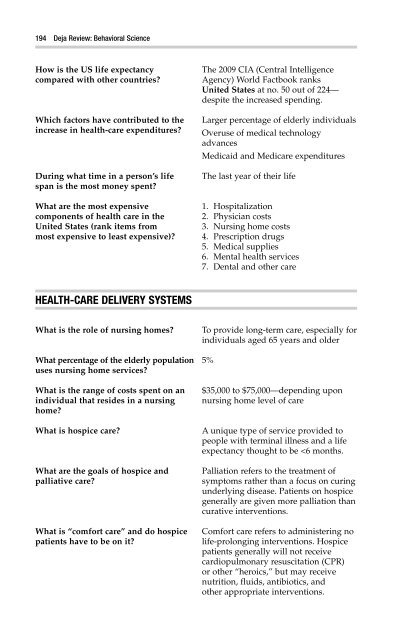Behavioral Science
Create successful ePaper yourself
Turn your PDF publications into a flip-book with our unique Google optimized e-Paper software.
192 Deja Review: <strong>Behavioral</strong> <strong>Science</strong><br />
How many people do not have health<br />
insurance in the United States?<br />
What are some of the disadvantages<br />
of self-purchased individual<br />
health-care plans?<br />
What is “pooled risk”?<br />
What is fee-for-service?<br />
Who pays more for the same<br />
service—an uninsured patient<br />
paying out of pocket or an insurance<br />
company?<br />
What is a Diagnosis-related Group<br />
(DRG)?<br />
What two health-care costs are not<br />
covered by Medicare?<br />
Which government-funded insurance<br />
plan is funded completely by the<br />
federal government?<br />
What are the primary sources of funding<br />
for health-care insurance for US citizens?<br />
Which not-for-profit insurance carrier<br />
provides insurance for 30% to 50%<br />
of working citizens in all 50 states?<br />
The number continues to rise, but<br />
approximately 45 million plus people.<br />
It may be very difficult to qualify for<br />
these if you have any illnesses. They<br />
can also be prohibitively expensive.<br />
Insurance companies make money by<br />
having the average premium of their<br />
insured group be less than the total<br />
amount they pay out for that same<br />
group. Each person has a certain<br />
amount of “risk” for developing<br />
disease. Combining the risk to each<br />
person in a group is “pooling risk.”<br />
Each service that is done is billed<br />
separately (eg, a doctor visit, x-ray,<br />
lab test, and surgical procedure are<br />
each charged for separately).<br />
The uninsured patient. Insurance<br />
companies negotiate discounted rate<br />
with physicians and hospitals—if a<br />
patient pays out of pocket, they have<br />
to pay full price.<br />
With DRGs, a hospital is paid a set<br />
amount for an individual diagnosis, no<br />
matter how long it takes to get better.<br />
For example, Patient A gets pneumonia<br />
and stays in the hospital 2 days, Patient B<br />
gets pneumonia also and takes a 10-day<br />
stay to recover. Medicare pays the hospital<br />
the same $1500 for Patient A as for<br />
Patient B.<br />
1. Long-term nursing care<br />
2. Outpatient prescription drugs<br />
Medicare. Medicaid receives funding<br />
from the federal and state governments<br />
both.<br />
Employee benefit.<br />
People obtain health-care insurance on<br />
their own.<br />
Blue Cross/Blue Shield<br />
Note: Blue Cross covers hospital costs.<br />
Blue Shield covers diagnostic tests and<br />
physicians’ fees.



